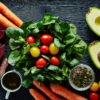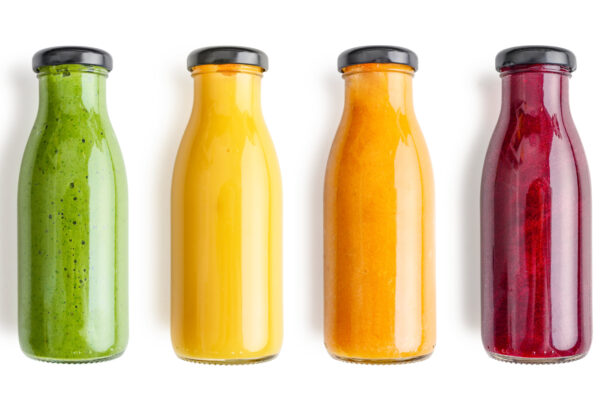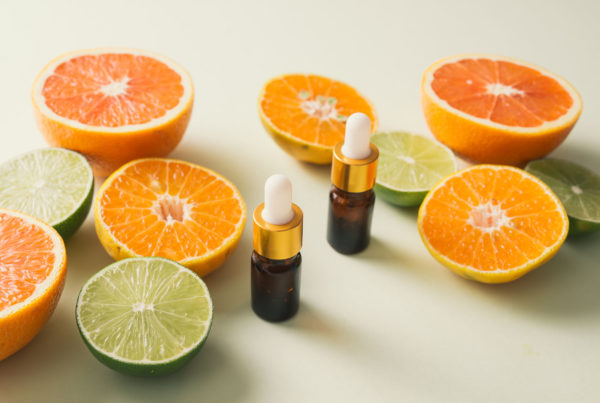” The COVID-19 pandemic changed people's eating and lifestyle habits.As we pass the halfway point of 2021, have you noticed any popular nutrition or lifestyle trends that were affected by the pandemic? Check out this week's article for 10 notable trends that may help you improve your overall wellness!
Reading time: 10 Minutes
MWi Hack:
- Follow 10 top trends and understand how to try them yourself
- Read up on additional information linked in this article to improve your wellness knowledge
The coronavirus pandemic has really changed the way we eat and shop for food, as well as renewed our interest in staying healthy. With that in mind, we identified trends—some new and some continuing to take off—that we think will be big in health and wellness next year. Here’s what we expect to see more of.
1. Immunity
It should come as no surprise that immunity is a hot ticket item. Views of immunity articles on EatingWell.com are up over 700% year-over-year and people are particularly interested in recipes to help their immune systems, including soups, salads, and breakfasts. While following guidelines from the Centers for Disease Control and Prevention and your local public health department is important to help stop the spread of diseases like COVID-19, there are things you can do to keep your immune system as healthy as possible. Get enough sleep, exercise regularly, reduce stress in your life, and eat a well-balanced diet. Certain nutrients, like vitamins A, C, and D, as well as zinc, all support your immune system (see the top 5 nutrients to eat for immunity). We think we’ll continue to see an interest in immunity in 2021, with more companies calling out immunity-boosting nutrients in their products.
2. Gut Health
By now, you’re probably familiar with probiotics: good-for-your-gut bugs found in fermented foods like yogurt and kimchi. But it’s not just probiotics that are important for gut health. Prebiotics, a type of fiber, and even postbiotics, a functional fermentation compound, are popping up more and more. Readership of EatingWell.com articles that covered digestion grew 163% this year and we think this has more to do with an interest in healthy guts than the toilet paper shortage.
According to Jessie Price, editor-in-chief of EatingWell magazine, “Gut health is one of the most exciting frontiers of nutrition and health research out there right now. People are devouring information about it and getting savvier and savvier. That means that, in addition to products touting probiotics, we’re going to see tons of products leading with prebiotics—and shoppers will be there to snap them up.”
Prebiotics are found in asparagus, Jerusalem artichokes (also called sunchokes), walnuts and wheat (learn more about prebiotics and where to find them), and we’re also seeing them added to everything from energy bars and candy to drinks. A healthy gut is also tied to a healthy immune system, which might be why people are trying extra hard to keep their microbiomes healthy.
3. Anti-Inflammation
Everyone wants to eat to beat inflammation: Views of inflammation content on EatingWell.com were over 250% higher this year than last year. People were particularly interested in sneaky signs you may have inflammation and inflammation-fighting meals you can make in 20 minutes. Inflammation is a normal response that our bodies have to help protect us from injuries and defend against foreign invaders. But too much inflammation over time can do damage in your body. Diseases associated with chronic inflammation include cancer, heart disease and arthritis. While nutrition experts have known for awhile that too much inflammation isn’t good, it seems there’s more general awareness these days, and everyone’s looking for ways to help with chronic inflammation, starting with their diet. (Here are some of the top foods to fight inflammation.)
The good news? Inflammation-fighting foods are generally the types of foods we encourage as part of a healthy diet. Salmon, nuts, beans, leafy greens, avocado, citrus fruit and berries are just some of the foods that give you an edge on fighting inflammation. Read our article The Best Foods to Fight Inflammation to learn more. The Mediterranean diet is another style of eating that can help curb inflammation and is a popular and healthy way of eating.
4. Plant Protein
Plant proteins have been increasing in popularity for a while, but they stand to be even more popular next year. Between Impossible Foods and Beyond Meat coming out with plant-based “beef” that mimics ground beef, and super-creative new plant-based dairy products (such as milks made from yellow peas), we’re continuing to see growth in this area. Basic meat-replacing staples like eggplant and lentils are also big. Plants tend to be cheaper than meat. Think of using a 99-cent can of beans in your tacos instead of a $5-plus pound of ground beef.
“Plant-based meals are hot right now and that trend is not going away anytime soon,” says Carolyn Malcoun, food features editor at EatingWell. “There is a growing understanding among consumers, particularly younger people, that eating as much meat as most Americans eat is not the greatest for the environment or our health. And we know that even substituting a few meatless meals a week can make a big difference.” Views of EatingWell vegan recipes are up 64% year-over-year (the popularity of lentil recipes grew a whopping 147%) and, according to Google Trends, searches for plant proteins, like chickpeas, tofu and black beans, hit an all-time high in 2020. Expect to see people leaning more into plant-based next year, even if they keep meat in their diet.
5. Air Frying
People did a lot more cooking at home this year, and one appliance they leaned on was the air fryer. Air fryer content on EatingWell.com is up 239% in 2020 over 2019. Breana Killeen, EatingWell’s Test Kitchen manager, says “Air fryers are basically mini-convection ovens that heat up in minutes and create a crispy texture on food with virtually no oil. The old versions were small—only holding enough food for about two servings but the new extra-large versions can cook enough food in one batch to serve at least four, if not six. I was skeptical about adding another appliance to my already-packed pantry, but the air fryer really does make the most delicious home fries, fish sticks, chicken nuggets and calamari—all without more than a quick coat of cooking spray.”
6. Chicory Root
“As long as I can remember I’ve associated chicory root with the New Orleans-style coffee with chicory I drink when I visit my family in Louisiana. But while the brew served at places like Café du Monde is a blend of coffee with roasted chicory root, we’re seeing more and more interest in pure chicory root “coffee,” a roasted chicory root beverage people drink as a caffeine-free replacement for coffee,” says Megan O. Steintrager, senior digital food editor at EatingWell.com. Chicory root is also being added to food products to deliver fiber, in the form of inulin, which is a prebiotic (and the gut health trend comes full circle). According to a report from Grand View Research, the global chicory market is anticipated to grow to almost $300 million by 2025, growing steadily every year thanks to more people being aware of the health benefits.
You won’t find a lot of fiber in chicory-root coffee, since it’s strained out, but it is delicious straight up or as a coffee blend, especially with a side of air-fryer beignets.
7. Drinking Less
One side effect of staying home during the pandemic may have been drinking more alcohol to cope. But as the months wore on, it’s possible people have started to notice the effects of too much drinking. Our surveys show that 25% of EatingWell readers practice cutting back on alcohol to help them achieve their health goals, including weight maintenance. Alcohol is one of the worst things you can drink for your immune system, and too much booze isn’t good for our bodies. Luckily, if you abstain you have more options these days than just water. Breweries are crafting quality nonalcoholic beer, and many companies are creating lower-alcohol brews. Not to mention, sparkling waters are more creative and flavorful than ever. Sales of seltzer and sparkling water are up 13% year-over-year, according to a Beverage Industry report.
8. Gardening
This is one wellness trend we love to see. Gardening is obviously nothing new, but the pandemic caused a huge surge in people growing their own food—and this is a trend we expect to stick around. Google searches for gardening normally peak in the early spring and in 2020 they doubled compared to 2019. Seed companies reported selling 8 to 10 times more seeds than they typically do. Hopefully, everyone can get their seeds in 2021 and whether they plant in pots or harvest a whole raised bed, they’ll be able to grow more local food right in their own backyard. Gardening is healthy on its own—it can help lower stress, build muscle, and boost your mood—and it also helps you eat more vegetables (here are 9 awesome health benefits of gardening).
9. Sleep
We’re seeing an interest in sleep as part of an overall wellness plan. Maybe that’s because we spent more time at home close to our beds (or anxiously lying awake in our beds) this year. According to Pinterest’s 2021 Trends Report, “Zzz time is the new me time.” They’re reporting spikes in searches for sleep yoga, sleep affirmations, silk sleepwear, and sleep blends for diffusers. We know sleep is important for your health—it can impact your immune system, your cravings, your mood, your skin, and more (here’s what happens in your body when you don’t get enough sleep). Views of EatingWell.com articles on sleep grew 138% in 2020. Help yourself get more sleep by following these 4 Ways to Get a Better Night’s Sleep, According to an Expert.
10. Adaptogens
“Adaptogens are huge right now. People are—understandably!—looking for all-natural ways to de-stress and focus better. In addition to adaptogen supplements, companies are now putting the compound into everything from teas, hot chocolate mix, and honey to face creams,” says Shaun Dreisbach, nutrition & features editor at EatingWell. If you’ve never heard of adaptogens, just wait. Perhaps you’ve seen mushroom coffee or ashwagandha powder added to an energy bar. Since adaptogens have the potential to help your immune system and reduce stress, we’re predicting they’re going to be big in 2021. Searches for “mushroom coffee” and “ashwagandha” were at an all-time high in 2020, per Google Trends.
MWi would like to thank Lisa Valente for sharing her expert insights with our community through the EatingWell Platform. Read the original article:
http://www.eatingwell.com/article/7881336/eatingwells-top-10-health-and-wellness-trends-for-2021/
More on the Author:
As the digital nutrition & news editor for EatingWell.com, Lisa Valente is passionate about communicating the latest nutrition science and trends in a clear, concise, and relatable way with the goal of balancing nutrition with realism and deliciousness. She also helps set and uphold brand nutrition standards and guide recipe development from a nutrition and health perspective. You can find Lisa sharing her knowledge in an array of EatingWell video content, from Facebook Live segments to a series highlighting the healthiest options to eat while on the road. She joined EatingWell in 2013 as associate nutrition editor for the magazine.
Lisa studied at the University of Vermont, where she completed her undergraduate studies in nutrition, food science, and dietetics, and attended the dietetic internship program at Massachusetts General Hospital to become a registered dietitian. She went on to earn a master’s degree in nutrition communication from the Friedman School of Nutrition Science and Policy at Tufts University. Prior to EatingWell, Lisa worked as a research dietitian at Griffin Hospital in Connecticut and also taught cooking and nutrition classes. She was a featured speaker at the Academy of Nutrition and Dietetics annual Food & Nutrition Conference & Expo (FNCE) in 2017.






